Fly Fishing in Belize
Over the last few years,
more and more of our friends and clients have asked us to develop
a winter fishing opportunity. 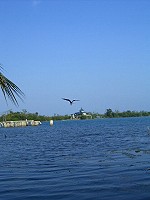 Every
time we started to talk about it, our Associate Preston kept shouting
BELIZE - BELIZE. Preston has been taking groups of student to Belize
for several years and knew the areas to explore and those to avoid.
This spring Preston had to make a trip to arrange for a couple of
his student's special projects. So, we followed his advice, and
off we went to discover what fly fishing opportunities Belize had
to offer.
Every
time we started to talk about it, our Associate Preston kept shouting
BELIZE - BELIZE. Preston has been taking groups of student to Belize
for several years and knew the areas to explore and those to avoid.
This spring Preston had to make a trip to arrange for a couple of
his student's special projects. So, we followed his advice, and
off we went to discover what fly fishing opportunities Belize had
to offer.
It was a humbling experience. I have not been saltwater fly fishing for a few years, and it amazed me how much I had forgotten about the difference between the salt flats and our more familiar rivers and streams. The equipment is so much bigger and in saltwater sixty feet or more casts are common. And, there is always the wind.
A couple of weeks before we left I dusted off my 8 weight rod and took it down to the park to practice. I could still cast 70 feet out without too much trouble. Of course that was on the grass and there was no wind. But on the flats, I found 60 feet was a struggle. The problem was getting the long, heavy line off the water and producing enough line speed. Next time I'll practice more on the water instead of on the grass. Of course, in Kansas you don't have to look too hard for wind.
 Our first day fishing was Saturday March 19th.
As Charles Dickens said, "It was the best of times; it was
the worst of times". The "best of times" was our
guide, Wyatt Cabral. Wyatt is world famous not only as a fishing
guide but also from his appearance on the cover of Orvis's "Fly
Fishing Catalog".The
"worst of times" was a sudden change in the weather. A
strong low-pressure area came in overnight, and the wind and tides
made flat fishing impossible. That was fine with us since we had
wanted at least one day in the lagoon to fish the mangroves for
Snook.
Our first day fishing was Saturday March 19th.
As Charles Dickens said, "It was the best of times; it was
the worst of times". The "best of times" was our
guide, Wyatt Cabral. Wyatt is world famous not only as a fishing
guide but also from his appearance on the cover of Orvis's "Fly
Fishing Catalog".The
"worst of times" was a sudden change in the weather. A
strong low-pressure area came in overnight, and the wind and tides
made flat fishing impossible. That was fine with us since we had
wanted at least one day in the lagoon to fish the mangroves for
Snook.
All-day long Wyatt poled us along as we continued to cast our chartreuse clousers and oversized poppers right to the edge of the mangroves. Only twice did we hear a snook back in the mangroves chasing something. By evening all we had was one medium sized yellow tail snapper. But we did see several pods of manatees; a treat that made the whole worthwhile.
 Sunday the 20th and Tuesday the 22nd our guide
was Dermin Shivers.The
weather had cleared and the tides were back to normal.Both mornings
we meet Dermin on the beach before 6:30 - he was in a hurry to get
us into his boat the "Rum Runner" so we could take advantage
of the tide. Dermin is obsessed with Permit! He has been fishing
for them all his life, and knows where to find them. Dermin took
us to several little, out-of-the-way flats that other guides ignored,
and every one had tailing Permit.
Sunday the 20th and Tuesday the 22nd our guide
was Dermin Shivers.The
weather had cleared and the tides were back to normal.Both mornings
we meet Dermin on the beach before 6:30 - he was in a hurry to get
us into his boat the "Rum Runner" so we could take advantage
of the tide. Dermin is obsessed with Permit! He has been fishing
for them all his life, and knows where to find them. Dermin took
us to several little, out-of-the-way flats that other guides ignored,
and every one had tailing Permit.
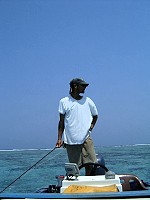 It only takes a moment on the flats to understand
why Permit are the "Holy Grail" of fly fishing. You have
to know where to find them, and you have to be there when the tide
is right. Finally, you have to be lucky! Permit are fickle, spooky,
and for a fish with such power, they are delicate eaters. We would
watch a group of 4 or 5 fish slowly tailing along the flats. Dermin
would get us into position to cast about 3 feet in front of them.
We waited nervously for them to reach our little crab pattern, but
they would casually turn to the right or left and never get to our
fly. And, Permit are notoriously spooky so you have to make perfect
casts. If your cast lands too hard or too close, all you have to
show for your time is a swirl of water where they had been.
It only takes a moment on the flats to understand
why Permit are the "Holy Grail" of fly fishing. You have
to know where to find them, and you have to be there when the tide
is right. Finally, you have to be lucky! Permit are fickle, spooky,
and for a fish with such power, they are delicate eaters. We would
watch a group of 4 or 5 fish slowly tailing along the flats. Dermin
would get us into position to cast about 3 feet in front of them.
We waited nervously for them to reach our little crab pattern, but
they would casually turn to the right or left and never get to our
fly. And, Permit are notoriously spooky so you have to make perfect
casts. If your cast lands too hard or too close, all you have to
show for your time is a swirl of water where they had been.
Like Captain Ahab, Dermin has his own Moby Dick - in this case Willy. Willy is a big Permit that taunts you. We were after Willy, and Dermin got us in position to make the cast. Just three feet from him and our crab pattern landed with a gentle plop. Closer and closer Willy tailed; just six inches from the fly and on a dead course for it. Then a frigate bird flew over and its shadow sent Willy off to the depths at the edge of the flat.
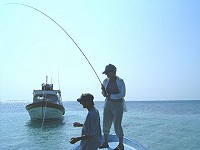 For a fish with as much folklore as Permit, we
thought they would attack our crab patterns. Not so - they just
suck in the fly and crush it. To the novice it feels no different
from the feel of the fly bumping into a little coral head.Finally,
a Permit stayed on track for the fly without a bird's shadow or
poor cast to send it scurrying for the depths.I was sure I should
have caught him but my fly snagged momentarily on the coral. When
I told Dermin, a smile crossed his face. "Let me see your fly",
he said. "I'll bet those lead eyes are flattened". They
were. My coral bump had been the Permit's jaws crushing the crab.
All I had needed to do was a strip stick and keep my knuckles away
from the handle of the reel.
For a fish with as much folklore as Permit, we
thought they would attack our crab patterns. Not so - they just
suck in the fly and crush it. To the novice it feels no different
from the feel of the fly bumping into a little coral head.Finally,
a Permit stayed on track for the fly without a bird's shadow or
poor cast to send it scurrying for the depths.I was sure I should
have caught him but my fly snagged momentarily on the coral. When
I told Dermin, a smile crossed his face. "Let me see your fly",
he said. "I'll bet those lead eyes are flattened". They
were. My coral bump had been the Permit's jaws crushing the crab.
All I had needed to do was a strip stick and keep my knuckles away
from the handle of the reel.
Each
morning we concentrated on working the Permit flats during the rising
and high tides, and didn't fish for bone fish. Once the tide turned,
Dermin took us into a sheltered cove of a cay to fish for schooling
bones in four to six feet of water. 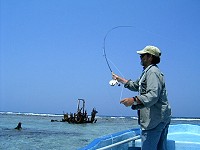 It was great fishing. Cast into
the school, let your fly sink to the bottom and then make a couple
of six inch strips. Any resistance and you pull back hard. Bone
fish run when hooked. First, at high-speed, they run straight away
from you. About the time they are into your backing, they turn and
come straight back at you just as fast as they went out. If you
manage to get the line tight enough for them to feel it, they likely
will head down into the sand. After a couple of these runs you can
get them to the boat.
It was great fishing. Cast into
the school, let your fly sink to the bottom and then make a couple
of six inch strips. Any resistance and you pull back hard. Bone
fish run when hooked. First, at high-speed, they run straight away
from you. About the time they are into your backing, they turn and
come straight back at you just as fast as they went out. If you
manage to get the line tight enough for them to feel it, they likely
will head down into the sand. After a couple of these runs you can
get them to the boat.
After our session with bones we headed into a tarpon lagoon. Unfortunately there were two other boats already in the lagoon. For about an hour we joined the others in casting toward schools of sardines, letting our fly sink, and stripping them back.Sometimes we would see a four-foot "baby tarpon" roll through one the schools but neither our boat, nor the other boats had any luck.
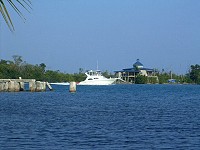 On our last day we headed for the barrier reef
and the remains of an old wreck - an area teaming with jacks and
snappers. Jacks may not get the good press that Permit and Bonefish
get but they are exciting to catch. They cruise in schools chasing
bait fish or hang out as individuals around pieces of the wreck
or coral heads. For schools, a cast of a clouser right in front
of them was all it would take. More often than not, a fish would
hit it before we had even started stripping it. Around the remains
of the wreck it would usually take a few strips to produce a strike.
Unlike Permit or Bones there was no doubt when you had a fish.
On our last day we headed for the barrier reef
and the remains of an old wreck - an area teaming with jacks and
snappers. Jacks may not get the good press that Permit and Bonefish
get but they are exciting to catch. They cruise in schools chasing
bait fish or hang out as individuals around pieces of the wreck
or coral heads. For schools, a cast of a clouser right in front
of them was all it would take. More often than not, a fish would
hit it before we had even started stripping it. Around the remains
of the wreck it would usually take a few strips to produce a strike.
Unlike Permit or Bones there was no doubt when you had a fish.
We found that an 8 weight rod was too much. A 7 weight or even a 6 weight would be more than enough, even with wind. In fact, a Winston LT5 4 wt caught most of the midsized Bones and all the Bar Jacks. Since many people normally fish a 5 or 6 weight rod, the step up to a 7 would not require many changes and adjustments. For Tarpon, a 7 weight might be a bit on the light side. It wouldn't be a casting issue; rather, it would be a landing issue. They called 30 pound fish "baby tarpon".
This was, without a doubt, the most exciting and enjoyable "winter" fly fishing experience we're ever had. Preston was right - Belize is the place for winter fly fishing. Come join us next year!